Epidemiology of Coronary Artery Diseases
VerifiedAdded on 2022/11/18
|11
|2174
|244
AI Summary
This report comprises of the Epidemiology of Coronary Artery Diseases. The acquaintance of Coronary Artery Diseases has made extraordinary paces during past 15years. Data shows that Coronary Artery Diseases are the foremost basis of the death in individuals. Therefore, new procedures like “electron beam computed tomography” have allowed the researchers and investigators to perceive the originators of CAD in asymptomatic patients.
Contribute Materials
Your contribution can guide someone’s learning journey. Share your
documents today.
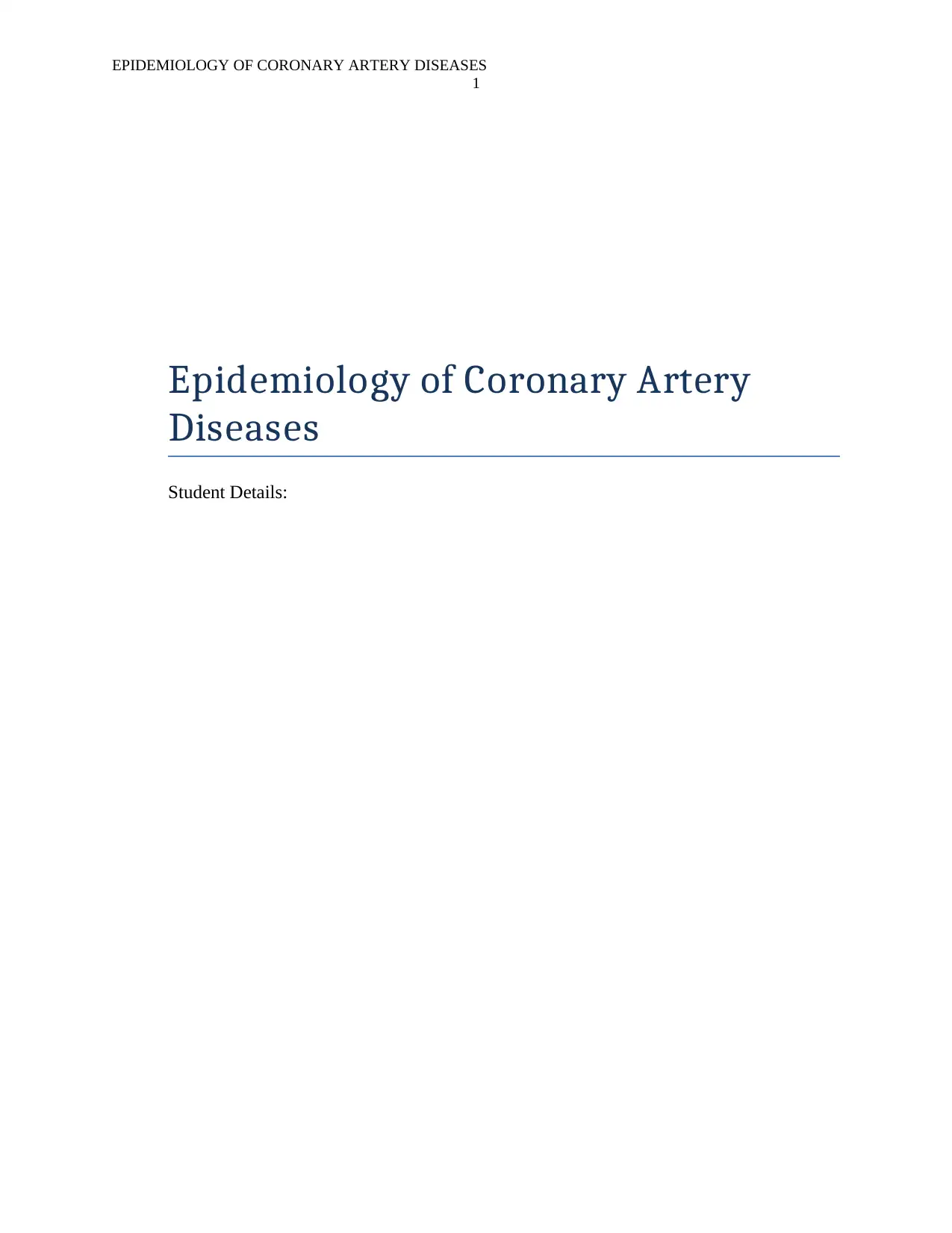
EPIDEMIOLOGY OF CORONARY ARTERY DISEASES
1
Epidemiology of Coronary Artery
Diseases
Student Details:
1
Epidemiology of Coronary Artery
Diseases
Student Details:
Secure Best Marks with AI Grader
Need help grading? Try our AI Grader for instant feedback on your assignments.
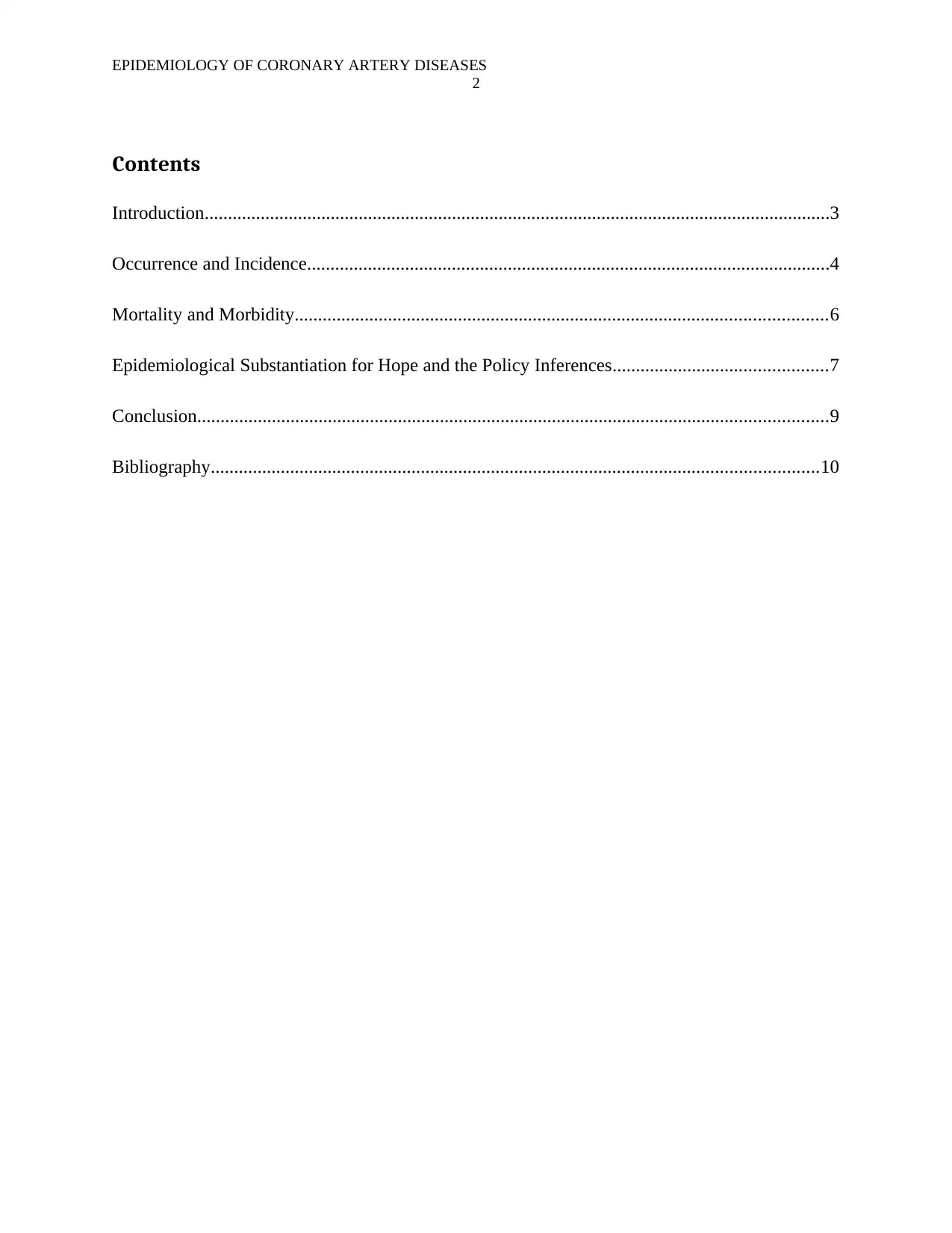
EPIDEMIOLOGY OF CORONARY ARTERY DISEASES
2
Contents
Introduction......................................................................................................................................3
Occurrence and Incidence................................................................................................................4
Mortality and Morbidity..................................................................................................................6
Epidemiological Substantiation for Hope and the Policy Inferences..............................................7
Conclusion.......................................................................................................................................9
Bibliography..................................................................................................................................10
2
Contents
Introduction......................................................................................................................................3
Occurrence and Incidence................................................................................................................4
Mortality and Morbidity..................................................................................................................6
Epidemiological Substantiation for Hope and the Policy Inferences..............................................7
Conclusion.......................................................................................................................................9
Bibliography..................................................................................................................................10
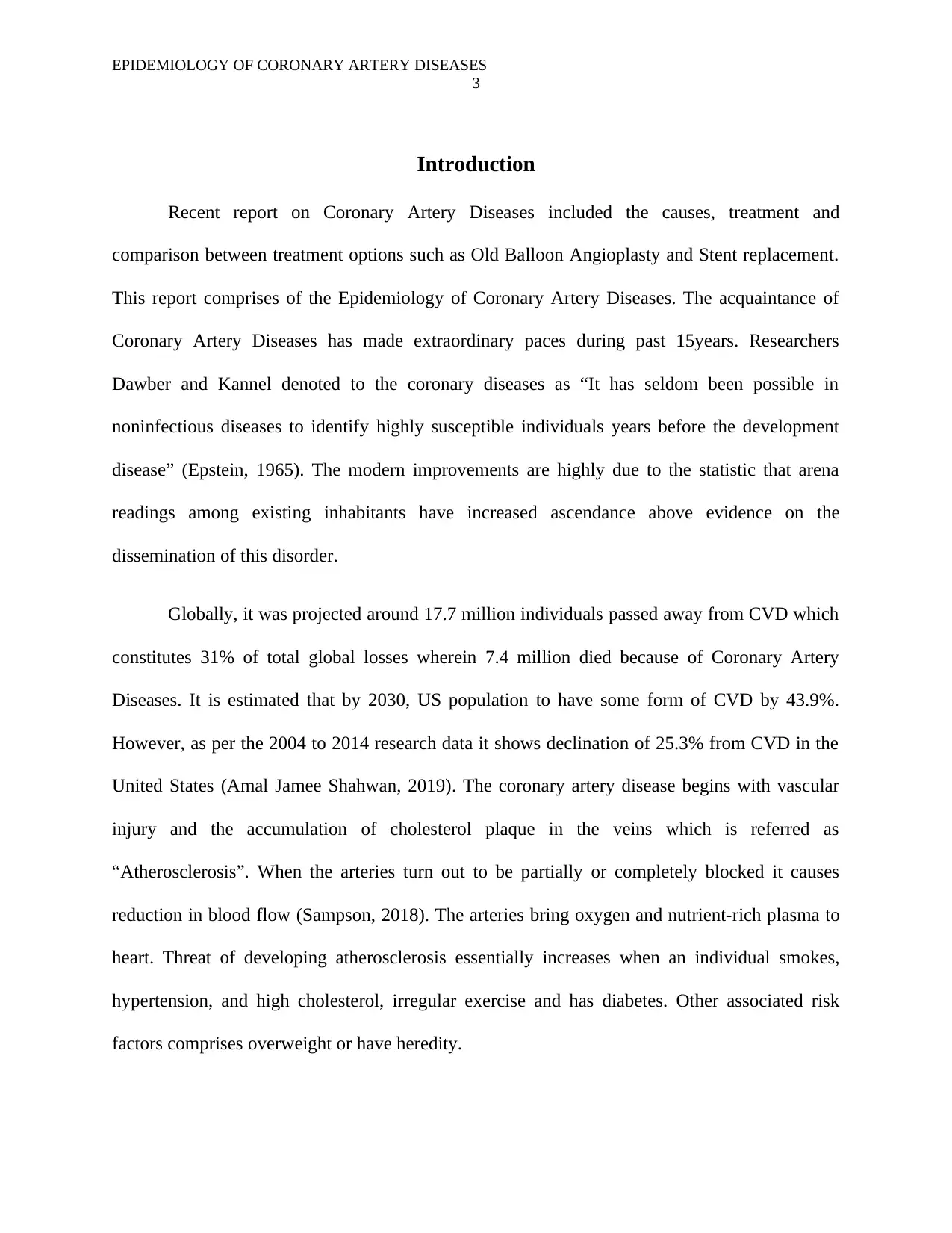
EPIDEMIOLOGY OF CORONARY ARTERY DISEASES
3
Introduction
Recent report on Coronary Artery Diseases included the causes, treatment and
comparison between treatment options such as Old Balloon Angioplasty and Stent replacement.
This report comprises of the Epidemiology of Coronary Artery Diseases. The acquaintance of
Coronary Artery Diseases has made extraordinary paces during past 15years. Researchers
Dawber and Kannel denoted to the coronary diseases as “It has seldom been possible in
noninfectious diseases to identify highly susceptible individuals years before the development
disease” (Epstein, 1965). The modern improvements are highly due to the statistic that arena
readings among existing inhabitants have increased ascendance above evidence on the
dissemination of this disorder.
Globally, it was projected around 17.7 million individuals passed away from CVD which
constitutes 31% of total global losses wherein 7.4 million died because of Coronary Artery
Diseases. It is estimated that by 2030, US population to have some form of CVD by 43.9%.
However, as per the 2004 to 2014 research data it shows declination of 25.3% from CVD in the
United States (Amal Jamee Shahwan, 2019). The coronary artery disease begins with vascular
injury and the accumulation of cholesterol plaque in the veins which is referred as
“Atherosclerosis”. When the arteries turn out to be partially or completely blocked it causes
reduction in blood flow (Sampson, 2018). The arteries bring oxygen and nutrient-rich plasma to
heart. Threat of developing atherosclerosis essentially increases when an individual smokes,
hypertension, and high cholesterol, irregular exercise and has diabetes. Other associated risk
factors comprises overweight or have heredity.
3
Introduction
Recent report on Coronary Artery Diseases included the causes, treatment and
comparison between treatment options such as Old Balloon Angioplasty and Stent replacement.
This report comprises of the Epidemiology of Coronary Artery Diseases. The acquaintance of
Coronary Artery Diseases has made extraordinary paces during past 15years. Researchers
Dawber and Kannel denoted to the coronary diseases as “It has seldom been possible in
noninfectious diseases to identify highly susceptible individuals years before the development
disease” (Epstein, 1965). The modern improvements are highly due to the statistic that arena
readings among existing inhabitants have increased ascendance above evidence on the
dissemination of this disorder.
Globally, it was projected around 17.7 million individuals passed away from CVD which
constitutes 31% of total global losses wherein 7.4 million died because of Coronary Artery
Diseases. It is estimated that by 2030, US population to have some form of CVD by 43.9%.
However, as per the 2004 to 2014 research data it shows declination of 25.3% from CVD in the
United States (Amal Jamee Shahwan, 2019). The coronary artery disease begins with vascular
injury and the accumulation of cholesterol plaque in the veins which is referred as
“Atherosclerosis”. When the arteries turn out to be partially or completely blocked it causes
reduction in blood flow (Sampson, 2018). The arteries bring oxygen and nutrient-rich plasma to
heart. Threat of developing atherosclerosis essentially increases when an individual smokes,
hypertension, and high cholesterol, irregular exercise and has diabetes. Other associated risk
factors comprises overweight or have heredity.
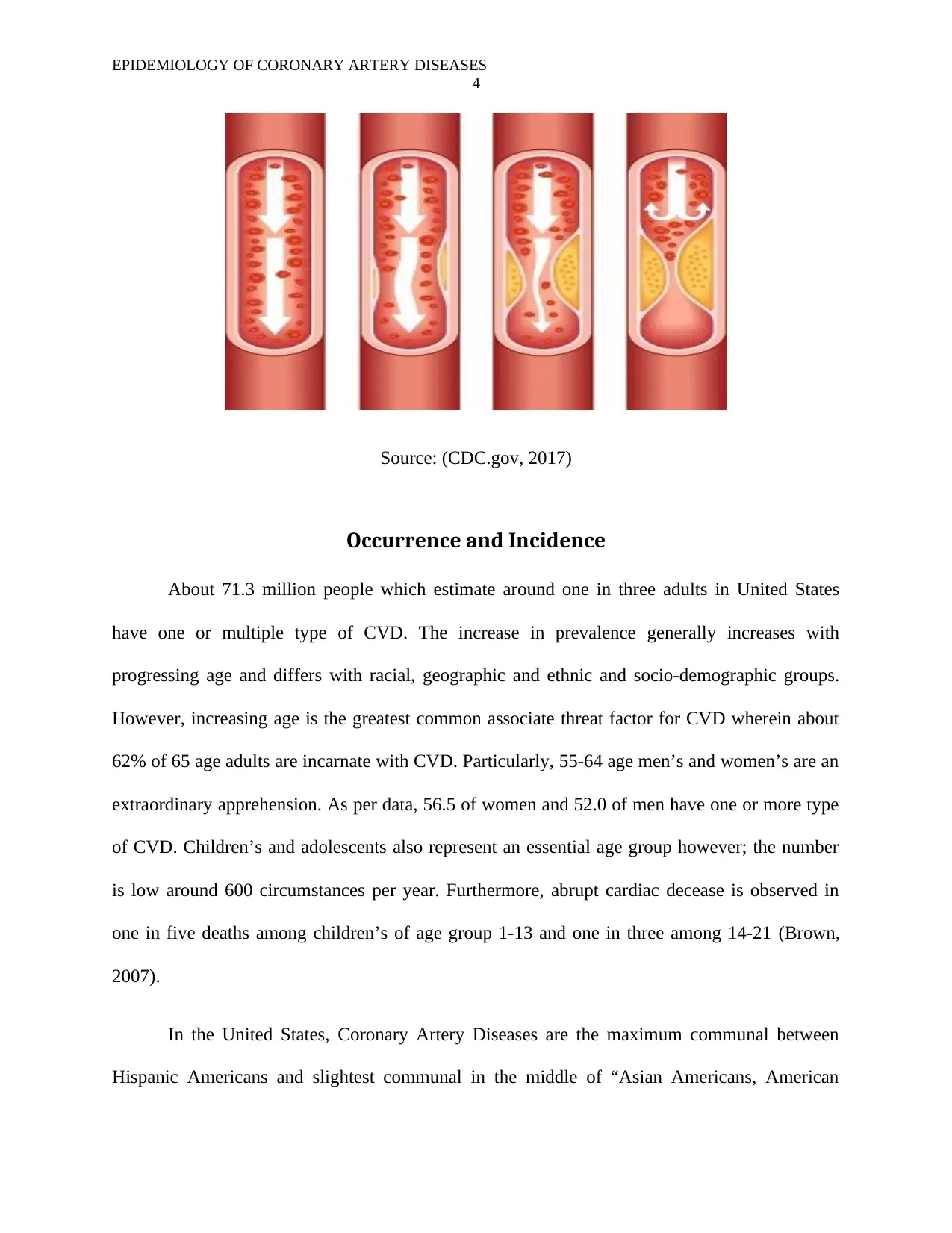
EPIDEMIOLOGY OF CORONARY ARTERY DISEASES
4
Source: (CDC.gov, 2017)
Occurrence and Incidence
About 71.3 million people which estimate around one in three adults in United States
have one or multiple type of CVD. The increase in prevalence generally increases with
progressing age and differs with racial, geographic and ethnic and socio-demographic groups.
However, increasing age is the greatest common associate threat factor for CVD wherein about
62% of 65 age adults are incarnate with CVD. Particularly, 55-64 age men’s and women’s are an
extraordinary apprehension. As per data, 56.5 of women and 52.0 of men have one or more type
of CVD. Children’s and adolescents also represent an essential age group however; the number
is low around 600 circumstances per year. Furthermore, abrupt cardiac decease is observed in
one in five deaths among children’s of age group 1-13 and one in three among 14-21 (Brown,
2007).
In the United States, Coronary Artery Diseases are the maximum communal between
Hispanic Americans and slightest communal in the middle of “Asian Americans, American
4
Source: (CDC.gov, 2017)
Occurrence and Incidence
About 71.3 million people which estimate around one in three adults in United States
have one or multiple type of CVD. The increase in prevalence generally increases with
progressing age and differs with racial, geographic and ethnic and socio-demographic groups.
However, increasing age is the greatest common associate threat factor for CVD wherein about
62% of 65 age adults are incarnate with CVD. Particularly, 55-64 age men’s and women’s are an
extraordinary apprehension. As per data, 56.5 of women and 52.0 of men have one or more type
of CVD. Children’s and adolescents also represent an essential age group however; the number
is low around 600 circumstances per year. Furthermore, abrupt cardiac decease is observed in
one in five deaths among children’s of age group 1-13 and one in three among 14-21 (Brown,
2007).
In the United States, Coronary Artery Diseases are the maximum communal between
Hispanic Americans and slightest communal in the middle of “Asian Americans, American
Secure Best Marks with AI Grader
Need help grading? Try our AI Grader for instant feedback on your assignments.
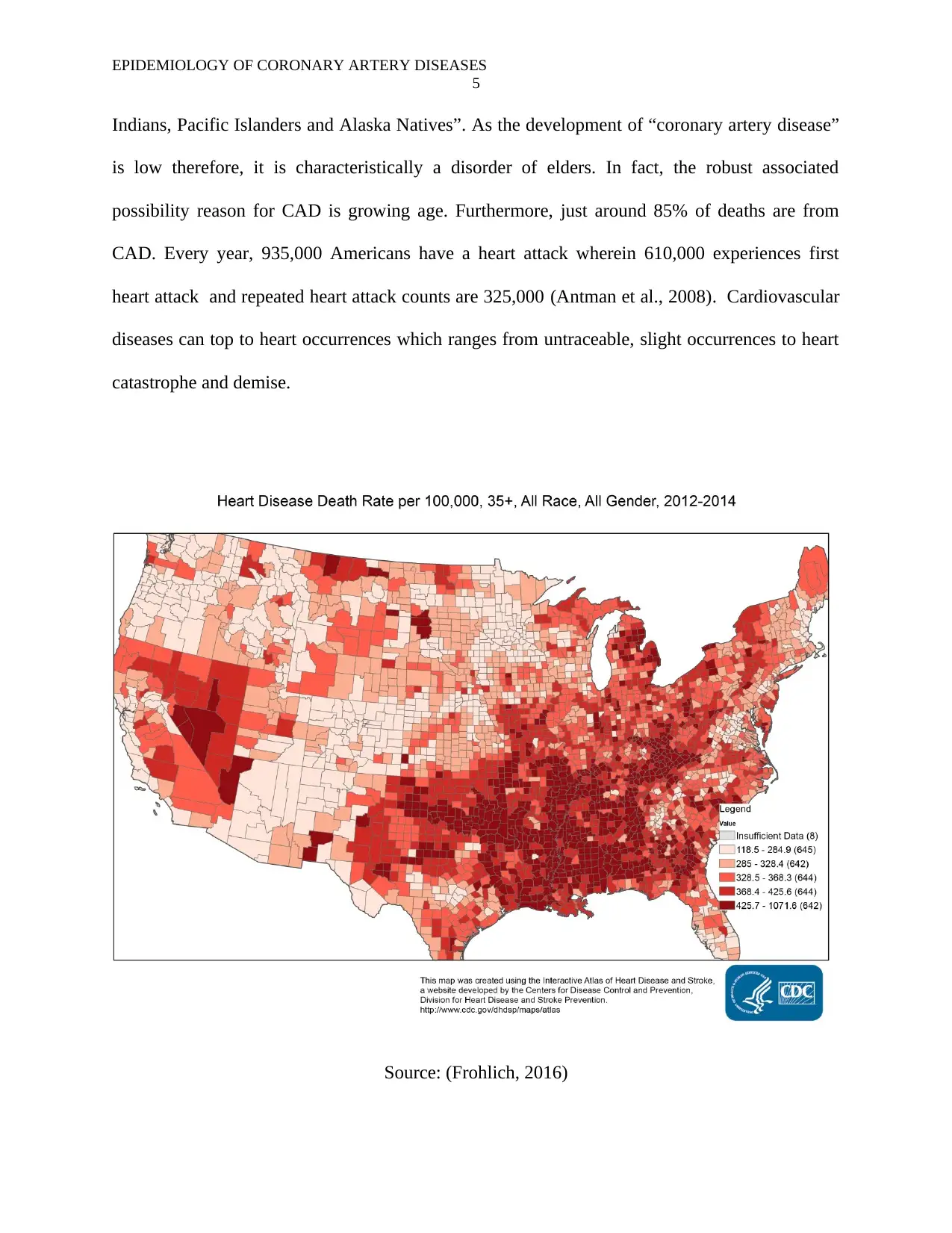
EPIDEMIOLOGY OF CORONARY ARTERY DISEASES
5
Indians, Pacific Islanders and Alaska Natives”. As the development of “coronary artery disease”
is low therefore, it is characteristically a disorder of elders. In fact, the robust associated
possibility reason for CAD is growing age. Furthermore, just around 85% of deaths are from
CAD. Every year, 935,000 Americans have a heart attack wherein 610,000 experiences first
heart attack and repeated heart attack counts are 325,000 (Antman et al., 2008). Cardiovascular
diseases can top to heart occurrences which ranges from untraceable, slight occurrences to heart
catastrophe and demise.
Source: (Frohlich, 2016)
5
Indians, Pacific Islanders and Alaska Natives”. As the development of “coronary artery disease”
is low therefore, it is characteristically a disorder of elders. In fact, the robust associated
possibility reason for CAD is growing age. Furthermore, just around 85% of deaths are from
CAD. Every year, 935,000 Americans have a heart attack wherein 610,000 experiences first
heart attack and repeated heart attack counts are 325,000 (Antman et al., 2008). Cardiovascular
diseases can top to heart occurrences which ranges from untraceable, slight occurrences to heart
catastrophe and demise.
Source: (Frohlich, 2016)
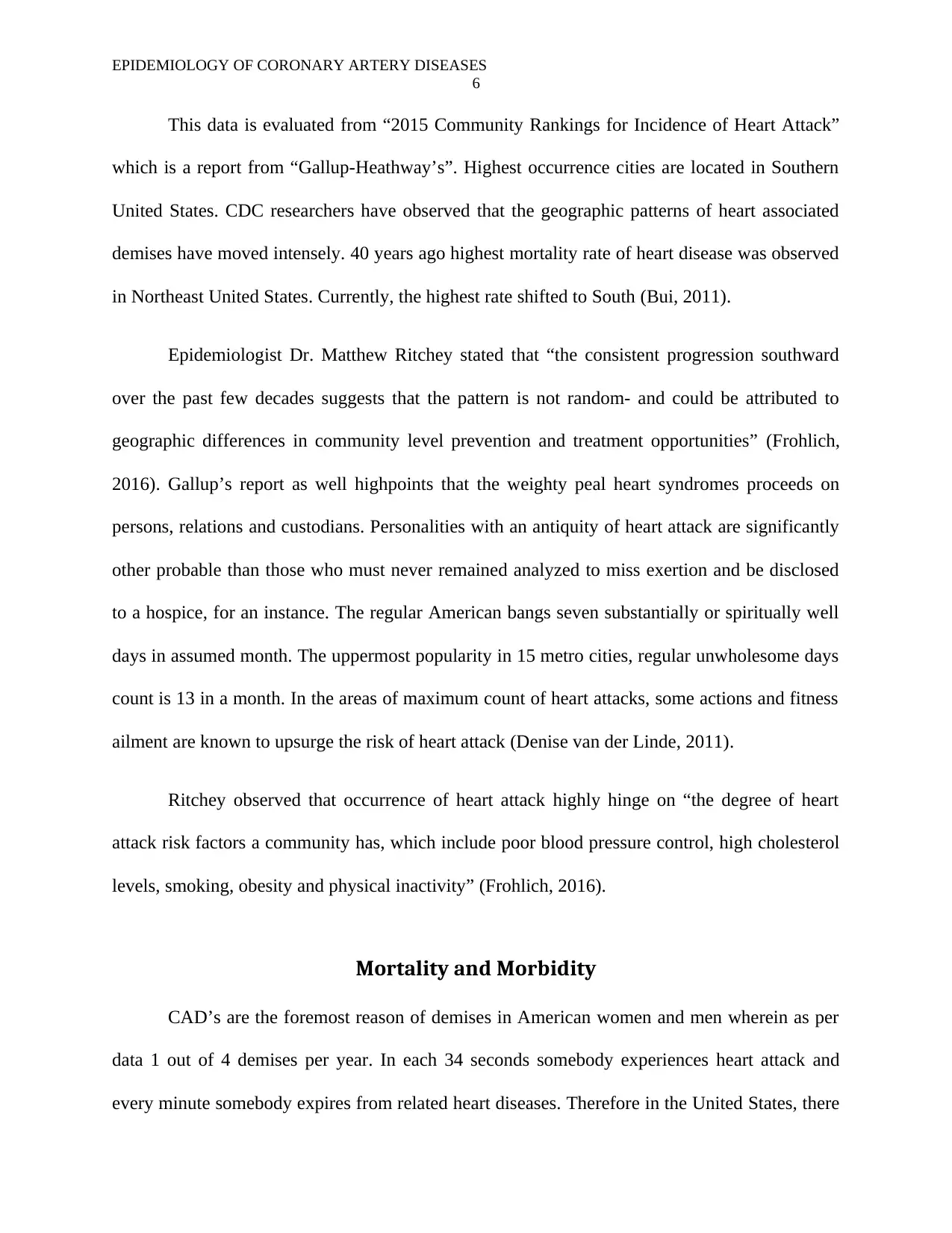
EPIDEMIOLOGY OF CORONARY ARTERY DISEASES
6
This data is evaluated from “2015 Community Rankings for Incidence of Heart Attack”
which is a report from “Gallup-Heathway’s”. Highest occurrence cities are located in Southern
United States. CDC researchers have observed that the geographic patterns of heart associated
demises have moved intensely. 40 years ago highest mortality rate of heart disease was observed
in Northeast United States. Currently, the highest rate shifted to South (Bui, 2011).
Epidemiologist Dr. Matthew Ritchey stated that “the consistent progression southward
over the past few decades suggests that the pattern is not random- and could be attributed to
geographic differences in community level prevention and treatment opportunities” (Frohlich,
2016). Gallup’s report as well highpoints that the weighty peal heart syndromes proceeds on
persons, relations and custodians. Personalities with an antiquity of heart attack are significantly
other probable than those who must never remained analyzed to miss exertion and be disclosed
to a hospice, for an instance. The regular American bangs seven substantially or spiritually well
days in assumed month. The uppermost popularity in 15 metro cities, regular unwholesome days
count is 13 in a month. In the areas of maximum count of heart attacks, some actions and fitness
ailment are known to upsurge the risk of heart attack (Denise van der Linde, 2011).
Ritchey observed that occurrence of heart attack highly hinge on “the degree of heart
attack risk factors a community has, which include poor blood pressure control, high cholesterol
levels, smoking, obesity and physical inactivity” (Frohlich, 2016).
Mortality and Morbidity
CAD’s are the foremost reason of demises in American women and men wherein as per
data 1 out of 4 demises per year. In each 34 seconds somebody experiences heart attack and
every minute somebody expires from related heart diseases. Therefore in the United States, there
6
This data is evaluated from “2015 Community Rankings for Incidence of Heart Attack”
which is a report from “Gallup-Heathway’s”. Highest occurrence cities are located in Southern
United States. CDC researchers have observed that the geographic patterns of heart associated
demises have moved intensely. 40 years ago highest mortality rate of heart disease was observed
in Northeast United States. Currently, the highest rate shifted to South (Bui, 2011).
Epidemiologist Dr. Matthew Ritchey stated that “the consistent progression southward
over the past few decades suggests that the pattern is not random- and could be attributed to
geographic differences in community level prevention and treatment opportunities” (Frohlich,
2016). Gallup’s report as well highpoints that the weighty peal heart syndromes proceeds on
persons, relations and custodians. Personalities with an antiquity of heart attack are significantly
other probable than those who must never remained analyzed to miss exertion and be disclosed
to a hospice, for an instance. The regular American bangs seven substantially or spiritually well
days in assumed month. The uppermost popularity in 15 metro cities, regular unwholesome days
count is 13 in a month. In the areas of maximum count of heart attacks, some actions and fitness
ailment are known to upsurge the risk of heart attack (Denise van der Linde, 2011).
Ritchey observed that occurrence of heart attack highly hinge on “the degree of heart
attack risk factors a community has, which include poor blood pressure control, high cholesterol
levels, smoking, obesity and physical inactivity” (Frohlich, 2016).
Mortality and Morbidity
CAD’s are the foremost reason of demises in American women and men wherein as per
data 1 out of 4 demises per year. In each 34 seconds somebody experiences heart attack and
every minute somebody expires from related heart diseases. Therefore in the United States, there
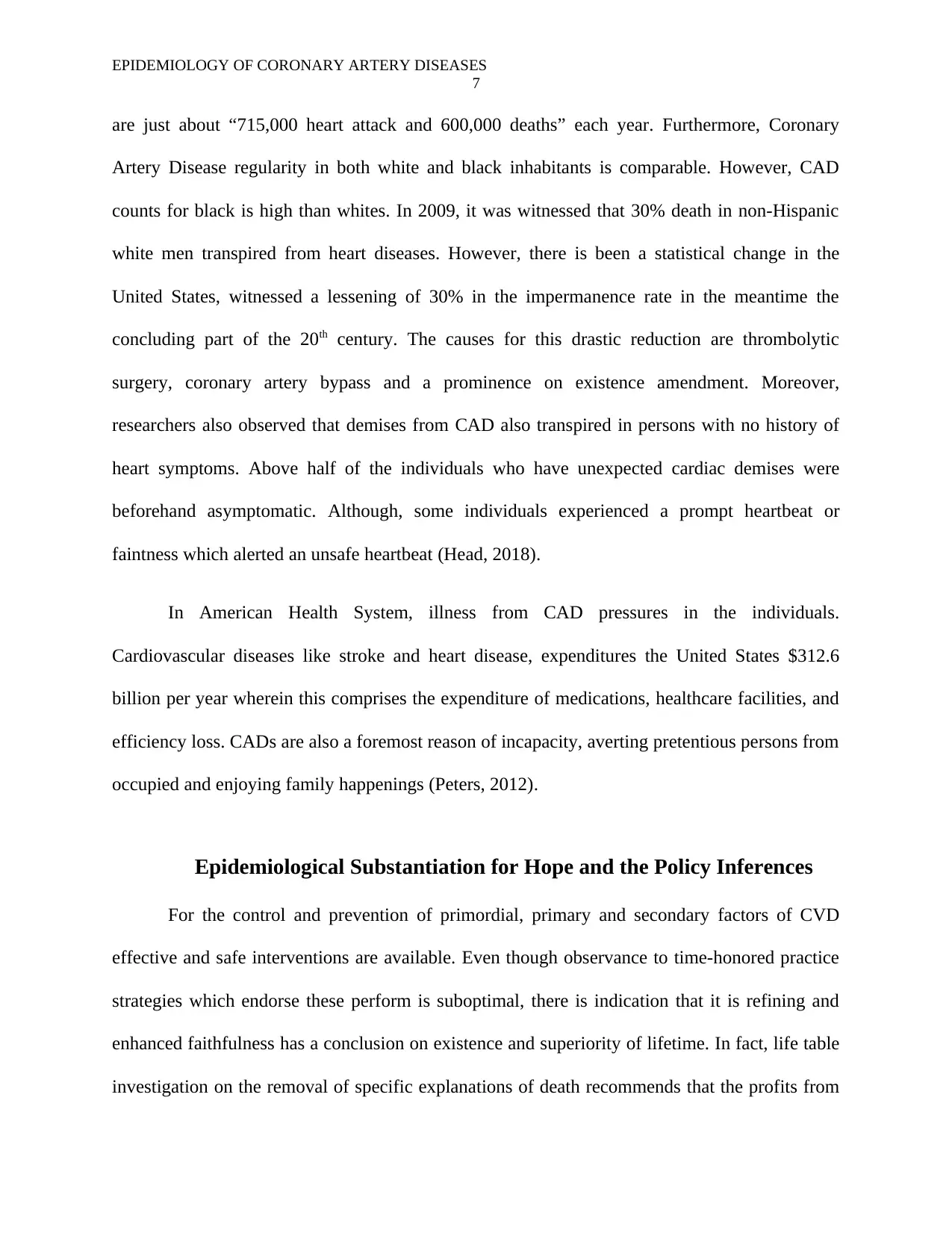
EPIDEMIOLOGY OF CORONARY ARTERY DISEASES
7
are just about “715,000 heart attack and 600,000 deaths” each year. Furthermore, Coronary
Artery Disease regularity in both white and black inhabitants is comparable. However, CAD
counts for black is high than whites. In 2009, it was witnessed that 30% death in non-Hispanic
white men transpired from heart diseases. However, there is been a statistical change in the
United States, witnessed a lessening of 30% in the impermanence rate in the meantime the
concluding part of the 20th century. The causes for this drastic reduction are thrombolytic
surgery, coronary artery bypass and a prominence on existence amendment. Moreover,
researchers also observed that demises from CAD also transpired in persons with no history of
heart symptoms. Above half of the individuals who have unexpected cardiac demises were
beforehand asymptomatic. Although, some individuals experienced a prompt heartbeat or
faintness which alerted an unsafe heartbeat (Head, 2018).
In American Health System, illness from CAD pressures in the individuals.
Cardiovascular diseases like stroke and heart disease, expenditures the United States $312.6
billion per year wherein this comprises the expenditure of medications, healthcare facilities, and
efficiency loss. CADs are also a foremost reason of incapacity, averting pretentious persons from
occupied and enjoying family happenings (Peters, 2012).
Epidemiological Substantiation for Hope and the Policy Inferences
For the control and prevention of primordial, primary and secondary factors of CVD
effective and safe interventions are available. Even though observance to time-honored practice
strategies which endorse these perform is suboptimal, there is indication that it is refining and
enhanced faithfulness has a conclusion on existence and superiority of lifetime. In fact, life table
investigation on the removal of specific explanations of death recommends that the profits from
7
are just about “715,000 heart attack and 600,000 deaths” each year. Furthermore, Coronary
Artery Disease regularity in both white and black inhabitants is comparable. However, CAD
counts for black is high than whites. In 2009, it was witnessed that 30% death in non-Hispanic
white men transpired from heart diseases. However, there is been a statistical change in the
United States, witnessed a lessening of 30% in the impermanence rate in the meantime the
concluding part of the 20th century. The causes for this drastic reduction are thrombolytic
surgery, coronary artery bypass and a prominence on existence amendment. Moreover,
researchers also observed that demises from CAD also transpired in persons with no history of
heart symptoms. Above half of the individuals who have unexpected cardiac demises were
beforehand asymptomatic. Although, some individuals experienced a prompt heartbeat or
faintness which alerted an unsafe heartbeat (Head, 2018).
In American Health System, illness from CAD pressures in the individuals.
Cardiovascular diseases like stroke and heart disease, expenditures the United States $312.6
billion per year wherein this comprises the expenditure of medications, healthcare facilities, and
efficiency loss. CADs are also a foremost reason of incapacity, averting pretentious persons from
occupied and enjoying family happenings (Peters, 2012).
Epidemiological Substantiation for Hope and the Policy Inferences
For the control and prevention of primordial, primary and secondary factors of CVD
effective and safe interventions are available. Even though observance to time-honored practice
strategies which endorse these perform is suboptimal, there is indication that it is refining and
enhanced faithfulness has a conclusion on existence and superiority of lifetime. In fact, life table
investigation on the removal of specific explanations of death recommends that the profits from
Paraphrase This Document
Need a fresh take? Get an instant paraphrase of this document with our AI Paraphraser
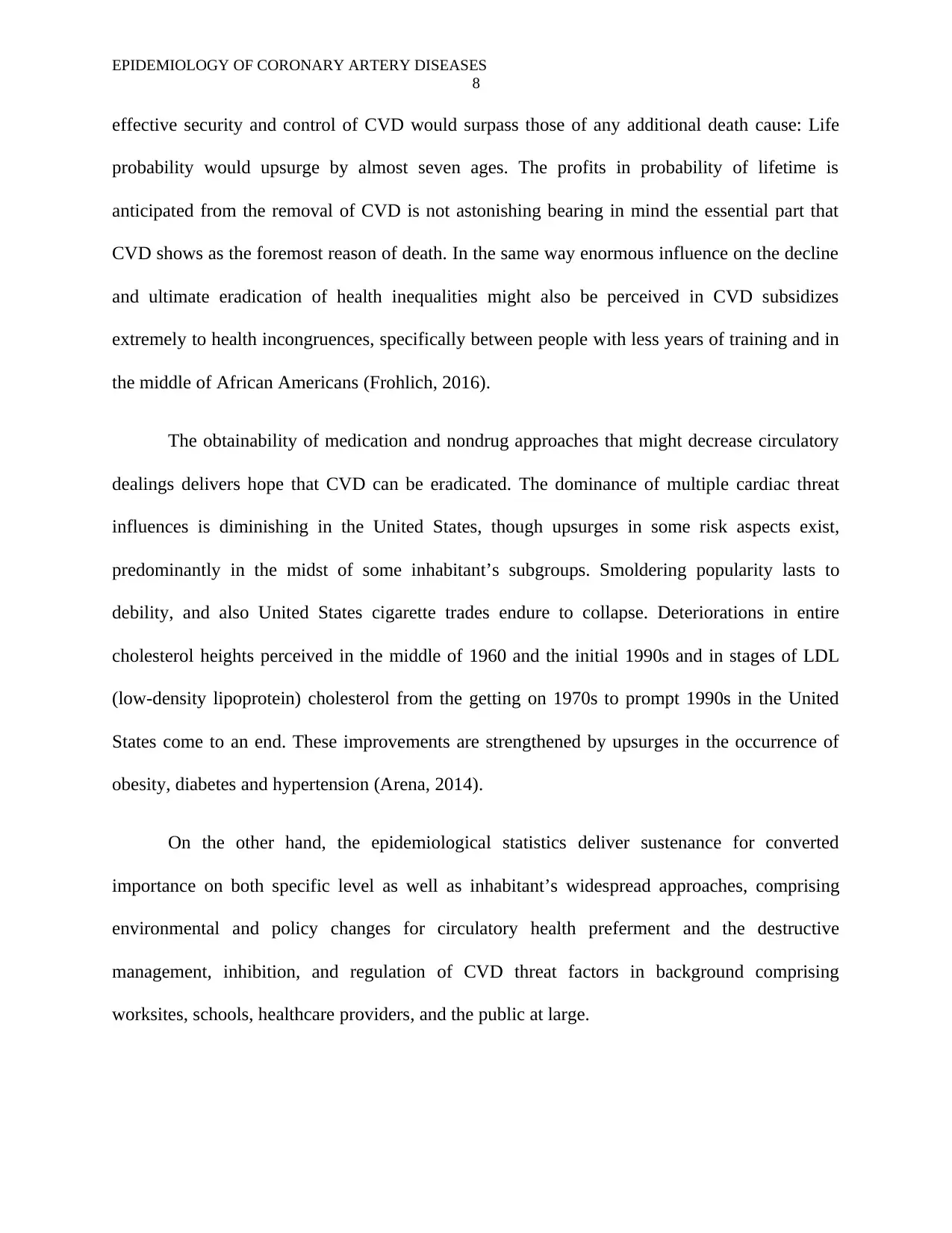
EPIDEMIOLOGY OF CORONARY ARTERY DISEASES
8
effective security and control of CVD would surpass those of any additional death cause: Life
probability would upsurge by almost seven ages. The profits in probability of lifetime is
anticipated from the removal of CVD is not astonishing bearing in mind the essential part that
CVD shows as the foremost reason of death. In the same way enormous influence on the decline
and ultimate eradication of health inequalities might also be perceived in CVD subsidizes
extremely to health incongruences, specifically between people with less years of training and in
the middle of African Americans (Frohlich, 2016).
The obtainability of medication and nondrug approaches that might decrease circulatory
dealings delivers hope that CVD can be eradicated. The dominance of multiple cardiac threat
influences is diminishing in the United States, though upsurges in some risk aspects exist,
predominantly in the midst of some inhabitant’s subgroups. Smoldering popularity lasts to
debility, and also United States cigarette trades endure to collapse. Deteriorations in entire
cholesterol heights perceived in the middle of 1960 and the initial 1990s and in stages of LDL
(low-density lipoprotein) cholesterol from the getting on 1970s to prompt 1990s in the United
States come to an end. These improvements are strengthened by upsurges in the occurrence of
obesity, diabetes and hypertension (Arena, 2014).
On the other hand, the epidemiological statistics deliver sustenance for converted
importance on both specific level as well as inhabitant’s widespread approaches, comprising
environmental and policy changes for circulatory health preferment and the destructive
management, inhibition, and regulation of CVD threat factors in background comprising
worksites, schools, healthcare providers, and the public at large.
8
effective security and control of CVD would surpass those of any additional death cause: Life
probability would upsurge by almost seven ages. The profits in probability of lifetime is
anticipated from the removal of CVD is not astonishing bearing in mind the essential part that
CVD shows as the foremost reason of death. In the same way enormous influence on the decline
and ultimate eradication of health inequalities might also be perceived in CVD subsidizes
extremely to health incongruences, specifically between people with less years of training and in
the middle of African Americans (Frohlich, 2016).
The obtainability of medication and nondrug approaches that might decrease circulatory
dealings delivers hope that CVD can be eradicated. The dominance of multiple cardiac threat
influences is diminishing in the United States, though upsurges in some risk aspects exist,
predominantly in the midst of some inhabitant’s subgroups. Smoldering popularity lasts to
debility, and also United States cigarette trades endure to collapse. Deteriorations in entire
cholesterol heights perceived in the middle of 1960 and the initial 1990s and in stages of LDL
(low-density lipoprotein) cholesterol from the getting on 1970s to prompt 1990s in the United
States come to an end. These improvements are strengthened by upsurges in the occurrence of
obesity, diabetes and hypertension (Arena, 2014).
On the other hand, the epidemiological statistics deliver sustenance for converted
importance on both specific level as well as inhabitant’s widespread approaches, comprising
environmental and policy changes for circulatory health preferment and the destructive
management, inhibition, and regulation of CVD threat factors in background comprising
worksites, schools, healthcare providers, and the public at large.

EPIDEMIOLOGY OF CORONARY ARTERY DISEASES
9
Conclusion
This report highlighted the Epidemiology of Coronary Artery Diseases in United States
wherein deliberations of occurrence, incidence, mortality, morbidity and health care policies are
included. Data shows that Coronary Artery Diseases are the foremost basis of the death in
individuals. Therefore, new procedures like “electron beam computed tomography” have
allowed the researchers and investigators to perceive the originators of CAD in asymptomatic
patients. Melancholy and CAD interrelates in a bidirectional method; despair is probable to
subsidize to the expansion of CAD. However, there is been a arithmetical modification in the
United States, as per the data and researches, countersigned a decline in the impermanence rate
in the intervening time The reasons for this sweeping decline are “thrombolytic surgery,
coronary artery bypass and a prominence on existence amendment”.
The supremacy of numerous cardiac hazard inspirations is shrinking in the United States,
all the same improvements in certain risk characteristics exist, for the most part in the middle of
some resident’s subcategories. Moreover, government has implemented health policies to
manage the threat of heart related diseases.
9
Conclusion
This report highlighted the Epidemiology of Coronary Artery Diseases in United States
wherein deliberations of occurrence, incidence, mortality, morbidity and health care policies are
included. Data shows that Coronary Artery Diseases are the foremost basis of the death in
individuals. Therefore, new procedures like “electron beam computed tomography” have
allowed the researchers and investigators to perceive the originators of CAD in asymptomatic
patients. Melancholy and CAD interrelates in a bidirectional method; despair is probable to
subsidize to the expansion of CAD. However, there is been a arithmetical modification in the
United States, as per the data and researches, countersigned a decline in the impermanence rate
in the intervening time The reasons for this sweeping decline are “thrombolytic surgery,
coronary artery bypass and a prominence on existence amendment”.
The supremacy of numerous cardiac hazard inspirations is shrinking in the United States,
all the same improvements in certain risk characteristics exist, for the most part in the middle of
some resident’s subcategories. Moreover, government has implemented health policies to
manage the threat of heart related diseases.
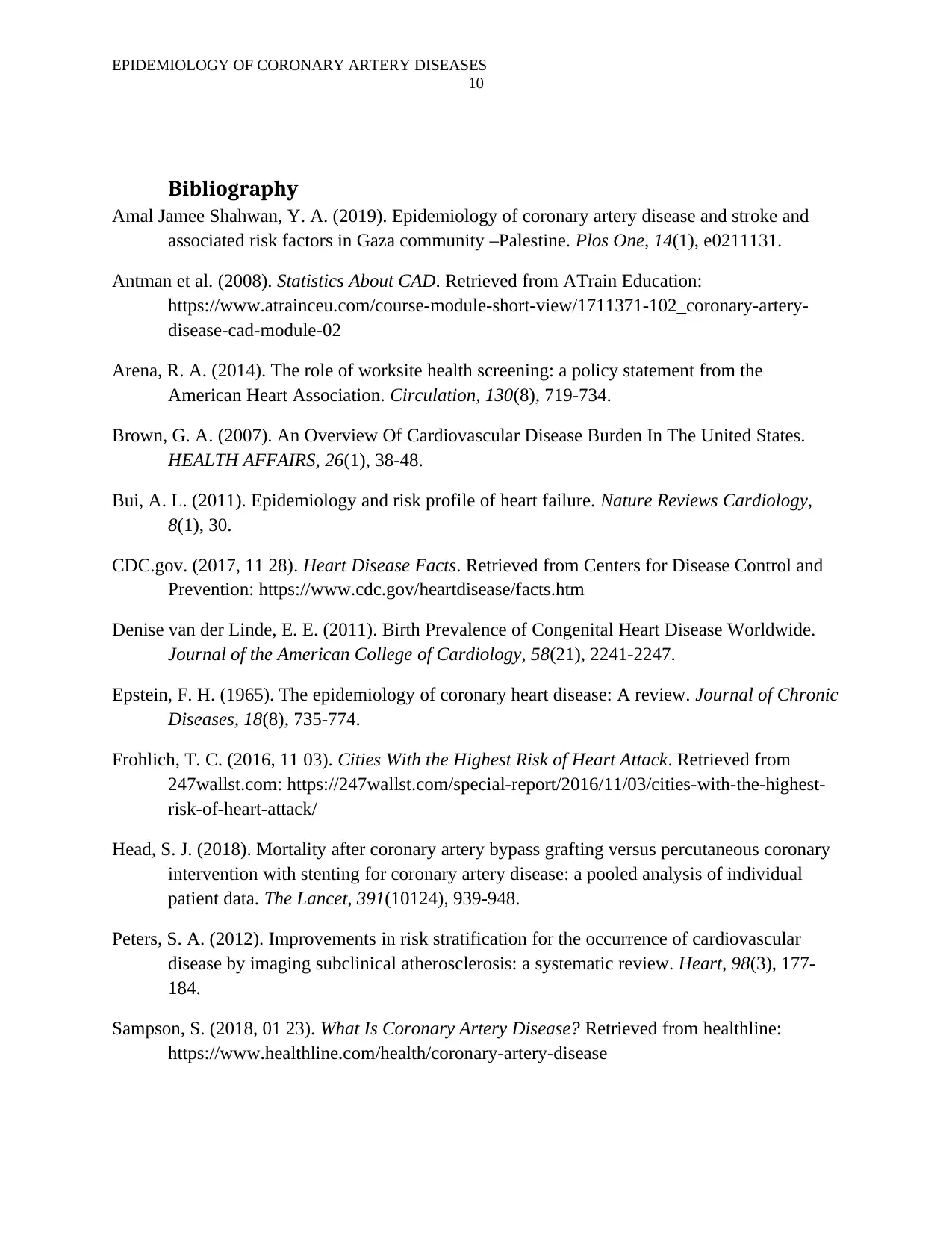
EPIDEMIOLOGY OF CORONARY ARTERY DISEASES
10
Bibliography
Amal Jamee Shahwan, Y. A. (2019). Epidemiology of coronary artery disease and stroke and
associated risk factors in Gaza community –Palestine. Plos One, 14(1), e0211131.
Antman et al. (2008). Statistics About CAD. Retrieved from ATrain Education:
https://www.atrainceu.com/course-module-short-view/1711371-102_coronary-artery-
disease-cad-module-02
Arena, R. A. (2014). The role of worksite health screening: a policy statement from the
American Heart Association. Circulation, 130(8), 719-734.
Brown, G. A. (2007). An Overview Of Cardiovascular Disease Burden In The United States.
HEALTH AFFAIRS, 26(1), 38-48.
Bui, A. L. (2011). Epidemiology and risk profile of heart failure. Nature Reviews Cardiology,
8(1), 30.
CDC.gov. (2017, 11 28). Heart Disease Facts. Retrieved from Centers for Disease Control and
Prevention: https://www.cdc.gov/heartdisease/facts.htm
Denise van der Linde, E. E. (2011). Birth Prevalence of Congenital Heart Disease Worldwide.
Journal of the American College of Cardiology, 58(21), 2241-2247.
Epstein, F. H. (1965). The epidemiology of coronary heart disease: A review. Journal of Chronic
Diseases, 18(8), 735-774.
Frohlich, T. C. (2016, 11 03). Cities With the Highest Risk of Heart Attack. Retrieved from
247wallst.com: https://247wallst.com/special-report/2016/11/03/cities-with-the-highest-
risk-of-heart-attack/
Head, S. J. (2018). Mortality after coronary artery bypass grafting versus percutaneous coronary
intervention with stenting for coronary artery disease: a pooled analysis of individual
patient data. The Lancet, 391(10124), 939-948.
Peters, S. A. (2012). Improvements in risk stratification for the occurrence of cardiovascular
disease by imaging subclinical atherosclerosis: a systematic review. Heart, 98(3), 177-
184.
Sampson, S. (2018, 01 23). What Is Coronary Artery Disease? Retrieved from healthline:
https://www.healthline.com/health/coronary-artery-disease
10
Bibliography
Amal Jamee Shahwan, Y. A. (2019). Epidemiology of coronary artery disease and stroke and
associated risk factors in Gaza community –Palestine. Plos One, 14(1), e0211131.
Antman et al. (2008). Statistics About CAD. Retrieved from ATrain Education:
https://www.atrainceu.com/course-module-short-view/1711371-102_coronary-artery-
disease-cad-module-02
Arena, R. A. (2014). The role of worksite health screening: a policy statement from the
American Heart Association. Circulation, 130(8), 719-734.
Brown, G. A. (2007). An Overview Of Cardiovascular Disease Burden In The United States.
HEALTH AFFAIRS, 26(1), 38-48.
Bui, A. L. (2011). Epidemiology and risk profile of heart failure. Nature Reviews Cardiology,
8(1), 30.
CDC.gov. (2017, 11 28). Heart Disease Facts. Retrieved from Centers for Disease Control and
Prevention: https://www.cdc.gov/heartdisease/facts.htm
Denise van der Linde, E. E. (2011). Birth Prevalence of Congenital Heart Disease Worldwide.
Journal of the American College of Cardiology, 58(21), 2241-2247.
Epstein, F. H. (1965). The epidemiology of coronary heart disease: A review. Journal of Chronic
Diseases, 18(8), 735-774.
Frohlich, T. C. (2016, 11 03). Cities With the Highest Risk of Heart Attack. Retrieved from
247wallst.com: https://247wallst.com/special-report/2016/11/03/cities-with-the-highest-
risk-of-heart-attack/
Head, S. J. (2018). Mortality after coronary artery bypass grafting versus percutaneous coronary
intervention with stenting for coronary artery disease: a pooled analysis of individual
patient data. The Lancet, 391(10124), 939-948.
Peters, S. A. (2012). Improvements in risk stratification for the occurrence of cardiovascular
disease by imaging subclinical atherosclerosis: a systematic review. Heart, 98(3), 177-
184.
Sampson, S. (2018, 01 23). What Is Coronary Artery Disease? Retrieved from healthline:
https://www.healthline.com/health/coronary-artery-disease
Secure Best Marks with AI Grader
Need help grading? Try our AI Grader for instant feedback on your assignments.

EPIDEMIOLOGY OF CORONARY ARTERY DISEASES
11
11
1 out of 11
Related Documents
Your All-in-One AI-Powered Toolkit for Academic Success.
+13062052269
info@desklib.com
Available 24*7 on WhatsApp / Email
![[object Object]](/_next/static/media/star-bottom.7253800d.svg)
Unlock your academic potential
© 2024 | Zucol Services PVT LTD | All rights reserved.





